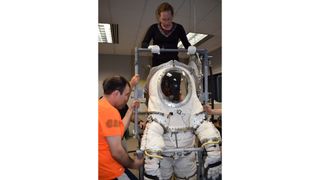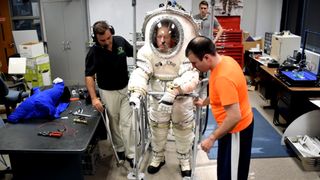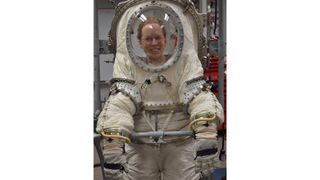GRAND FORKS, N.D. — Many students celebrate completing their Ph.D. with a party. I, ever the space nerd, climbed into a spacesuit instead.
I spent seven years studying remotely at the University of North Dakota (UND) here, which is home to a variety of space-related facilities. I studied crews at the Inflatable Lunar/Mars Habitat — a facility where groups of three or four people live as astronauts for a week or two, including venturing outside in pressurized spacesuits.
For months, I eavesdropped on Earth-bound simulated astronauts at this habitat to learn more about how they solve problems and display leadership in the field. But I never got to try on a spacesuit myself, since my home in Canada is at least a day’s journey away from UND by plane and car — and I work full time, in addition to the time I had to spend studying for my degree.
See the Gallery: Trying on a Spacesuit Brings Thrills and Challenges

University of North Dakota graduate students Joseph Clift (bottom left) and Bradley Hoffmann (right) help Space.com contributor Elizabeth Howell into the NDX-2 spacesuit. Operations like this one require trust between team members because the person wearing the spacesuit needs help to get in and out of the NDX-2 safely.
(Image: © Ana Salas/University of North Dakota)
But when I came to UND on May 31 to successfully defend my dissertation, I got a special invite — to see what a real spacesuit feels like. Pablo de León, a member of my dissertation committee, who also supervises the UND Human Spaceflight Laboratory, invited me to visit his spacesuit lab. I’ve written about the challenges of operating in spacesuits for years. Now, after nearly 25 years of reading about space and dreaming about being an astronaut, I’d finally get to experience a pressurized spacesuit.
Not a space station spacesuit
Development began in 2009 under a NASA grant, back when the agency planned on heading back to the moon under the now-canceled Constellation program. (NASA now wants to head back to the moon, landing humans by 2024.)
The spacesuit design is different from what you’ll see on the International Space Station. There, astronauts don what is essentially a three-piece suit — leggings on the bottom, a torso unit in the middle and a helmet on the top. But NDX-2 is a single piece that would-be astronauts climb into from the back. Constellation likely would have used this type of system, according to de León.
The one-piece system addresses a challenge of NASA’s current system, which relies on a waist bearing to connect the torso and leggings. The bearing allows for good twisting motion and lets the astronaut bend forward and backward. But the suit is heavier, more expensive and could leak at the bearing.
Simulation “astronauts” have used a version of NDX-2, known as the NDX-2AT (the AT stands for “analog training”), for eight consecutive missions at the Habitat. From listening to hours of recordings, I can tell you that being in that spacesuit is hard work — there’s a lot of heavy breathing and sounds of effort as the analog astronauts complete their duties. While my spacesuit was the laboratory version of NDX-2, de León said more modifications could be made to it to simulate lunar missions in the field.
Related: The Evolution of the Spacesuit in Pictures
Technical difficulties
De León gave me a safety briefing before I got into the spacesuit. I was to let him know if I experienced any feelings of claustrophobia or any loss of communication; the safety signal was to straighten my left arm and raise it up. De León reassured me that he and the graduate students helping that day (Joseph Clift and Bradley Hoffmann) could get me out in seconds if something happened.
De León planned to supervise my progress and stay in constant communication with me through a small radio intercom. Once I was sealed inside, Clift would be by my side to assist with procedures, while Hoffmann would remain in the same room near an air compressor to adjust the pressure inside the spacesuit as needed.
Then, de León and the students introduced me to my task, handing me simulated astronaut tools — a scoop and a gripper — to use to pick up some objects on the ground. Even before getting into the suit, I noticed that using the gripper to pick up the rocks and toys scattered on the carpet required a lot of hand strength. The scoop was easier to handle, but required some dexterity to move objects safely inside the bowl of the scoop.
The next challenge was simply getting into the suit. The rear-entry hatch was so high above the ground that I needed a stepladder to enter the suit. I grabbed a bar above the suit and pushed into the leggings. Once I popped my legs in, another issue quickly arose: my left foot got stuck — so painfully stuck that I could feel my left toenail digging against the plastic.

Space.com contributor Elizabeth Howell (top) grasps a bar to lower herself into the NDX-2 spacesuit. At left is University of North Dakota graduate student Joseph Clift. This is a laboratory version of the NDX-2, fixed in place for testing; a more flexible version is used in the field at the Inflatable Lunar/Mars Analog Habitat.
(Image: © Ana Salas/University of North Dakota)
Hoffmann and Clift could see I was bunched up, and we spent several minutes diagnosing the issue. I moved my foot. The students felt around for the ball of my foot and toe, and then moved the spacesuit material around. For long minutes, all I felt was fabric — then finally, I sensed a void under my heel. I knew that was where the boot was.
“I’m so close!” I said to the students as I wiggled my foot leftward, toward the empty space. With their careful help and some determined effort, I finally pushed down into the boot. Now I was ready for testing. De León installed my headset, put the air tube into my spacesuit and then (with the help of the students) sealed the back.
Snowsuit sensation
Inside the spacesuit, I felt two main sensations — the cool air blowing against my face and my body’s heat creating sweat and humidity. To slide inside the suit, I had been asked to wear long pants, long sleeves and even gloves, so de León urged me a few times to take my time during the testing and to avoid overheating. Fortunately, I enjoy warmer environments and I felt comfortable throughout.
The air pressure changes inside the suit were quite gradual and gentle — I’ve certainly experienced worse inside of airplanes. De León shouted so I could hear his voice above the noise of the rushing air. And then he told me it was time to do some flexibility tests. I raised my arms up, down, to the side — then flexed my hands. Standing in it felt like being inside a huge snowsuit — a snowsuit in which it was hard to move, or even see, my toes.

Space.com contributor Elizabeth Howell (in spacesuit) tries unsuccessfully to pick up items using a simulated astronaut tool. Visibility at the bottom of the astronaut helmet was limited, and her arms were too short to reach the ground. Assisting is Pablo de León, a space studies professor at the University of North Dakota (left), along with graduate students Joseph Clift (foreground right) and Bradley Hoffmann (background right).
(Image: © Ana Salas/University of North Dakota)
That latter problem came to the fore a few moments later, when de León asked me to use the tools in the spacesuit. I couldn’t see! When I looked down near my feet, the spacesuit fabric cut off my view and the helmet’s glass distorted what little I could see. Worse, I discovered that my arms were too short for the tool to reach the ground. We tried moving my arms underneath a support bar in front of the spacesuit, but I concluded that it was no use — I needed to grow longer arms.
Testing finished within minutes. De León opened the back of the suit and Clift urged me to try freeing my legs from the leggings using a bicycle-pedal motion. I gripped the bar and pulled, but I didn’t have enough strength in my upper body to pull out my legs. Quickly, Hoffmann and Clift adapted — they found a rolling office chair and pushed hard against the wheels to secure it against my feet. I pulled myself out, with only one slip when we let go of the chair a moment too soon.
Sweaty, tired and now in awe of astronauts who use spacesuits regularly, I stood beside NDX-2. Despite the many technical issues while wearing the suit, I was elated. For a few minutes, I felt like a real spaceflyer — doing experiments, fixing problems and above all, exploring the frontiers of engineering.

Space.com contributor Elizabeth Howell smiles in relief when both feet securely touch ground inside the spacesuit. The back of the spacesuit is still open but will be sealed shortly. Pressure inside the spacesuit is maintained with a nearby (off-camera) air compressor, which feeds air into the spacesuit through a plastic tube.
(Image: © Ana Salas/University of North Dakota)
- NASA’s Futuristic Z-2 Spacesuit Design in Pictures
- Photos: Meet the ‘Boeing Blue’ Spacesuit for Starliner Capsule
- Mars Spacesuits: Designing a Blue-Collar Suit for the Red Planet
Follow Elizabeth Howell on Twitter @howellspace. Follow us on Twitter @Spacedotcom and on Facebook.
Have a news tip, correction or comment? Let us know at community@space.com.
